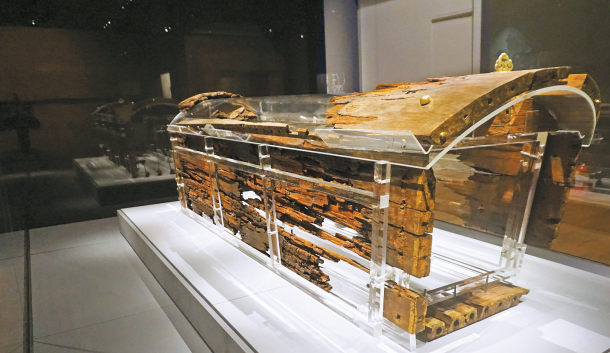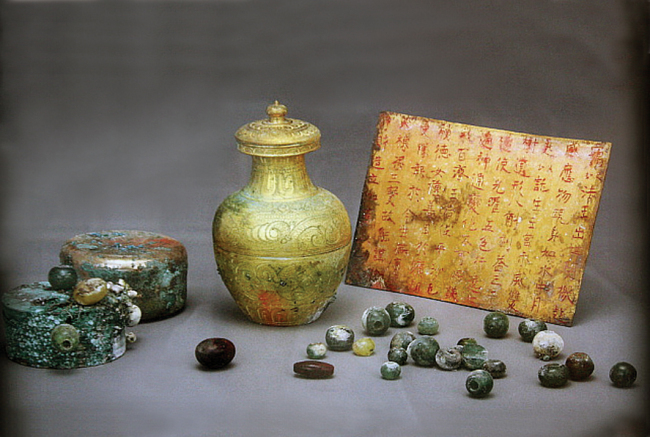NEWS
New Museum Reveals Buddhist Mysteries of Korea’s Baekje Kingdom

A wooden coffin discovered in 1917 inside a tomb in Iksan and believed to likely belong to
King Mu of the Baekje kingdom. From koreajoongangdaily.com
A new museum in South Korea opened its doors this month, offering visitors a rare glimpse into the Buddhist history of the ancient Baekje (백제) kingdom, which flourished from 18 BCE–660 CE, and an opportunity to view an impressive collection of key artifacts from the Korea’s long and profound relationship with Buddhism.
Iksan National Museum, which stands within the grounds of the ancient Mireuksa temple complex in southern North Jeolla Province, houses a collection of more than 23,000 Buddhist relics unearthed from around Mireuksa and dated to the Baekje kingdom, many of which are now on public display for the first time.
“Shown at the museum for the first time today are the gold thread embroidery that is [believed] to have wrapped the sarira [Skt. sacred relics] reliquaries found in the pagoda at Mireuk Temple site, a terra-cotta head of a monk, and a [royal] wooden coffin,” said Bae Ki-dong, director-general of the National Museum of Korea, which oversees Iksan National Museum. (Korea JoongAng Daily)
Established during the Baekje kingdom and located in the modern city of Iksan, a former capital of Baekje, Mireuksa was the largest temple in the ancient kingdom, which is notable for being instrumental in introducing and propagating Buddhism on the Korean Peninsula. Mireuksa was founded late in the reign of King Mu (r. 600–641), the 30th king of Baekje, and is now considered an example of the most advanced architectural skills of Three Kingdoms of Korea—Baekje, Goguryeo (later Goryeo), and Silla.
Among the highlights on display at the museum is a wooden coffin discovered inside a tomb some three kilometers from Mireuksa and believed to be the final resting place of King Mu, based on records from the Goryeo kingdom.

Top: Reliquaries unearthed during excavations of
the stone pagoda at Mireuksa. Bottom: The glass
tip of the innermost reliquary jar.
From koreajoongangdaily.com
“The coffin, first discovered in 1917, is being exhibited in its complete form for the first time in 103 years,” said curator Lee Yeong-beom. “It’s not 100 per cent confirmed who it was made for. Given that the wood used for the coffin is a type of Sciadopitys verticillata, a very expensive tree at the time, some experts think that this could have been the coffin made for King Mu.” (Korea JoongAng Daily)
Jeonju National Museum, which had stored the coffin from 2014–19, reopened the tomb in 2017, in the process discovered a wooden box containing 102 pieces of bone.
“Tests on the bone pieces showed that they belonged to a man in his 50s to 60s, who probably died between 620 and 659,” said Iksan National Museum. “This result led the experts to conclude tentatively again that the owner of the tomb was probably King Mu, given the years coinciding with his reign and his age at the time of his death.” (Korea JoongAng Daily)
Baekje, located in the southwest of the Korean Peninsula, was one of the Three Kingdoms of Korea that comprised the entire Korean Peninsula and parts of what is now northeastern China and far eastern Russia. Baekje was founded by King Onjo (r. 18 BCE–28 CE) at the early capital of Wiryeseong, in what is now southern Seoul. During its peak in the fourth century, Baekje controlled most of the western Korean peninsula and fostered political and trade links with China and Japan. Because of its maritime strength, Baekje was instrumental in disseminating Buddhism throughout East Asia.
Iksan National Museum has grown out of what was originally a small exhibition center in the Mireuksa complex. In 2015, the exhibition hall was upgraded to a national center following the UNESCO recognition world heritage sites in Iksan. The new national museum now has three main exhibition halls: the first showing relics found at the archaeological site of the royal palace of King Mu; a second hall housing reliquaries and relics discovered around Mireuksa; and a third exhibiting jars and pottery, gilt-bronze decorated shoes and crowns whose elements and designs point to intercultural activities in the time of Baekje.

Top: gold thread embroidery, and bottom: the
terra-cotta face of a monk, both dated to the Baekje
kingdom and on public display for the first time.
From koreajoongangdaily.com
Excavations of the Mireuksa site took place over an extended period from 1980–96, revealing the full size and layout of the temple grounds and buildings during the Baekje kingdom. More than 19,000 artifacts dating from the temple’s establishment up to the Joseon dynasty were discovered.
Mireuksa is also home to a recently restored pagoda—one of only two Baekje pagodas that have survived to the present day—that was officially unveiled last year after 18 years of extensive renovation.* The pagoda was designated a national treasure in 1962 and added to UNESCO’s World Heritage list in July 2015 as part of the Baekje Historic Areas World Heritage Site.*
Built at the height of Baekje during the reign of King Mu, the pagoda is believed to have originally had nine tiers, but lost its uppermost levels at some point in the 16th century during the Joseon dynasty (1392–1897), when Confucianism rose to prominence over Buddhism. During the course of the mammoth restoration project that ended last year, numerous relics were unearthed, some of which can now be viewed at the new museum.
“The inner-most glass jar that held the sarira was found broken,” said curator Sohn Hyun-kyung. “The sarira was held in three jars total. We have them on display here—the two outer jars and the tip of the inner-most jar that was found broken.” (Korea JoongAng Daily)
Another curator noted that because of its extreme fragility, the tip of the innermost jar would likely only be part of the exhibition for a very limited period.
The museum’s special exhibition room, which is open only until 29 March, contains a display of 15 sarira reliquaries found in Buddhist pagodas across Korea, several of which are listed as national treasures.

Sarira and other relics found inside the stone pagoda at the Mireuksa. From koreaherald.com
As of 2018, South Korea had 13 listed World Heritage sites,** many of which stand in testament to the country’s long and influential Buddhist heritage, including Seokguram Grotto and Bulguksa Temple in North Gyeongsang Province, the Baekje Historic Areas in South Chungcheong and North Jeolla, the Gyeongju Historic Areas in North Gyeongsang, and the mountain fortress city of Namhansanseong in Gyeonggi.
According to census data for 2015, the majority of South Korea’s population—56.1 per cent—holds no religious affiliation. Christians make up the largest religious segment of the population at 27.6 per cent, while Buddhists account for 15.5 per cent.
* Korea’s Oldest Stone Buddhist Pagoda Officially Unveiled after 20-year Restoration Project (Buddhistdoor Global)
** Seven Buddhist Mountain Temples in South Korea Receive UNESCO World Heritage Status (Buddhistdoor Global)
See more
In Iksan, the mysteries of Baekje are unearthed: New museum shows relics for first time since their discovery (Korea JoongAng Daily)
Time travel to ancient kingdom of Baekje (The Korea Herald)
Iksan National Museum
Related news from Buddhistdoor Global
Korea’s Jogye Order to Establish Buddhist Temple in Pakistan
Calligraphy by Revered Korean Buddhist Monk Samyeong Daesa on Public Display for the First Time
Sacred Dedication: Freer|Sackler Exhibits Rare 13th Century Korean Sculpture of Avalokiteshvara
Freer and Sackler Galleries Launch Digital Catalogue of Goryeo Buddhist Art
Goryeo Kingdom Exhibition in Seoul Celebrates Korea’s Buddhist History
Related features from Buddhistdoor Global
Engaged Buddhism: Seon Master Pomnyun Sunim Pledges 10,000 Tons of Food Aid for Children in North Korea
My Journey on the Path of Won Buddhism
Jungmyungsa Buddhist Temple: A Haven of Korean Buddhism in Queens














